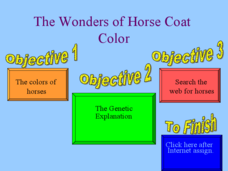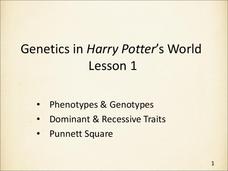Curated OER
Mendelian Genetics
Although these slides seem full of text, the information is bulleted and clear. There is a list of vocabulary and then two slides to define examples of Mendelian inheritance and rules of probability. The remaining five slides look at...
Beyond Benign
Punnett Square Possibilities
Discover possible genetic outcomes through Punnett Squares. Learners continue studying genetic traits in the 10th lesson in the 17-part series. After determining the father of Sparky's kittens, scholars now attempt to predict the traits...
Serendip
Should States Repeal Their Laws Banning First Cousin Marriage?
Around half of the states in the US ban first cousin marriage, but does science support that ban? Scholars work through genetic analysis of the risks to understand if more states should ban the practice—or if some should remove it. They...
Curated OER
Genetic Disorders
Students examine how living cells create new cells and how genetic mutations can cause disorders and be inherited. In this genetic reproductionn lesson students create their own PowerPoint presentation.
Curated OER
DNA, the Awesome Thread of Life
Students examine how traits are passed to offspring. In this genetic reproduction lesson students develop a model of dna and learn about its structure, replication and function.
Curated OER
EMS Lesson 2: Outrageous Offspring
Students investigate the principles of probability that can be used to predict hereditary traits.
Curated OER
Genetics Since Mendel
For this biology worksheet, 9th graders determine whether it is possible for two alleles to produce four genotypes. Then they state how many alleles there are for blood type. Students also determine which blood type is inherited by...
Curated OER
Nature and Nurture
Students look into the role both nature and nurture play in determining an individual's traits. They examine how genes and the environment affect personality
Curated OER
Heredity (Mendelian Genetics)
Students observe and record observations of whether a person is a taster or nontaster. They test selected individuals from their families and peer groups and chart all findings to determine which trait (e.g. taster or non-taster) is...
Curated OER
Human Heredity
Students apply their knowledge of simple and complex inheritance of human traits to this activity, which prompts students to fill in the blanks and complete the chart. The activity refers to Chaper 15 of an unnamed textbook, but it could...
Curated OER
The Wonders of Horse Coat Color
You won't be able to use a few of the slides in this presentation since the first lists objectives not met within, and the third gives instructions to a worksheet that is not included. You will, however, find the remaining slides useful...
Curated OER
Human Inheritance
Students analyze genetic characteristics in a given family tree through the F2 generation. Students apply prior knowledge from Gregor Mendel's study with pea plants and his Laws of Heredity to answer questions.
Curated OER
Dragon Genetics ~ Independent Assortment and Genetic Linkage
Imagine a pair of dragons that produce offspring. What percentage of the hatchlings have wings and large antlers? An engaging activity draws genetics learners in, introduces them to alleles, meiosis, phenotypes, genotypes, and teaches...
Utah Education Network (UEN)
Utah Open Textbook: 5th Grade Science
How do Earth's changes affect humans? Pupils learn about physical and chemical changes on Earth and how they lead to erosion, earthquakes, and volcanoes. Using the text, they also explore the concepts of electricity and magnetism by...
Science 4 Inquiry
Genetics, Genetics, and More Genetics: Exploring Independent Assortment and Non-Mendelian Genetics
Two individuals share 99.9 percent of their genetic codes, yet diversity is observed everywhere. Young scientists learn about diversity through hands-on activities and an experiment. They apply the concepts of independent assortment and...
Curated OER
Human Genetics
In this biology worksheet, 9th graders create a Punnett square to show the possible offspring of a carrier female and a normal male for color blindness. Then they draw a pedigree for the family and indicate whether the daughter is...
Curated OER
Heredity: Your Connection To The Past
Young scholars investigate genetics and the process of reproduction in living organisms.
Curated OER
Genes, not Jeans
Fifth graders examine the difference between dominant and recessive genes, and what happens when genes are combined. They complete a worksheet on genetics after observing if they can wiggle their ears or roll their tongues. They...
Curated OER
What Do Genes Look Like?
Seventh graders describe the basic structure of the DNA molecule. They identify what an inherited trait is and how it can be determined by one or more genes. Finally, 7th graders identify that plant and animal cells contain several...
US National Library of Medicine
Genetics in Harry Potter’s World Lesson 1
By the end of Harry Potter and the Deathly Hallows, we know Harry and Ginny get married, but what will their kids look like? This presentation introduces viewers to Punnett Squares and how to use them to determine both dominant and...
Serendip
Soap Opera Genetics – Genetics to Resolve Family Arguments
Did she cheat on her husband? Did the hospital switch the babies? Should they have children? As much as this sounds like the plot for a soap opera, all of these questions fit into a single lesson on genetics. Scholars read about three...
Personal Genetics Education Project
Scientific Themes in Personal Genetics
Humans can be tested for the presence of the BRCA gene, whose presence is an indicator that they have a greater chance of acquiring breast cancer than someone without the gene. Viewers have an opportunity to explore how genes and...
Biology Junction
Introduction to Biology
Welcome to Biology! Introduce pupils to a subject conceptualized by Aristotle in 300 BC through a presentation and worksheet. It covers the themes of biology, characteristics of life, the scientific method, microscopes, and measurements.
Serendip
DNA
Get up close and personal with DNA! A two-part hands-on activity has learners extract DNA from a small organism and then their own cheek cells. Scholars then explore DNA replication using questions to guide their analyses.
Other popular searches
- Learned and Inherited Traits
- Inherited Traits of Animals
- Inherited Traits of Plants
- Human Inherited Traits
- Inherited Traits Worksheets
- Inherited Traits Plants
- Genetics Inherited Traits
- Inherited Traits 4th Grade
- Inherited Traits in Plants
- Traits Inherited
- Concept of Inherited Traits
- Traits Inherited Environment

























